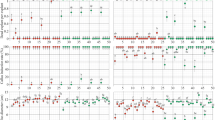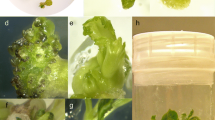Abstract
In citrus, production of mature transgenic plants belonging to different genotypes is an important biotechnological objective. In the present study, we tried to genetically transform and regenerate mature plants from the economically important Navelina sweet orange cultivar by using the procedure previously established for the genetically close Pineapple sweet orange variety. The use of BAP at 3 mg l−1 promoted efficient shoot organogenesis in Pineapple as expected, but not in Navelina. Furthermore, different effects were observed when the auxin α-naphtalene acetic acid (NAA) was added to BAP-containing regeneration media. Although NAA addition at 0.5 mg l−1 enhanced cambial callus formation, number of shoots and their elongation in Navelina, the contrary effect was observed in Pineapple. Moreover, transformation efficiency in Navelina rose from 0 to 3% but declined from 6 to 0% in Pineapple, indicating that BAP and BAP + NAA exerted the opposite effect in transgenic shoot regeneration from two closely related cultivars. This suggests that small changes in the procedure could induce drastic alterations in regeneration and even increase the likelihood of obtaining transformants from non-responsive genotypes. Moreover, the vigour of the starting plant material and the addition of kanamycin as selective agent were determining for the generation of mature sweet orange transgenic plants.





Similar content being viewed by others
Abbreviations
- BAP:
-
6-Benzylaminopurine
- CM:
-
Co-cultivation medium
- IM:
-
Inoculation medium
- NAA:
-
α-Naphtalene acetic acid
- SRM:
-
Shoot regeneration medium
References
Almeida WAB, Mourao Filho FAA, Pino LE et al (2003) Genetic transformation and plant recovery from mature tissues of Citrus sinensis L. Osbeck Plant Sci 164:203–211
Bordón Y, Guardiola JL, García-Luis A (2000) Genotype affects the morphogenic response in vitro of epicotyl segments of Citrus rootstocks. Ann Bot 86:159–166
Cervera M, Pina JA, Juárez J et al (1998a) Agrobacterium-mediated transformation of citrange: factors affecting transformation and regeneration. Plant Cell Rep 18:271–278
Cervera M, Juárez J, Navarro A et al (1998b) Genetic transformation and regeneration of mature tissues of woody fruit plants bypassing the juvenile stage. Transgenic Res 7:51–59
Cervera M, López MM, Navarro L et al (1998c) Virulence and supervirulence of Agrobacterium tumefaciens in woody fruit plants. Physiol Mol Plant Pathol 52:67–78
Dellaporta SL, Wood J, Hicks JB (1983) A plant DNA minipreparation: Version II. Plant Mol Biol Rep 4:19–21
Domínguez A, Cervera M, Pérez R et al (2004) Characterisation of regenerants obtained under selective conditions after Agrobacterium-mediated transformation of citrus explants reveals production of silenced and chimeric plants at unexpected high frequencies. Mol Breed 14:171–183
Duran-Vila N, Ortega V, Navarro L (1989) Morphogenesis and tissue cultures of three citrus species. Plant Cell Tiss Organ Cult 16:123–133
Durzan D (1990) Adult vs. juvenile explants: directed totipotency. In: Rodríguez R, Sánchez-Tamés R, Durzan DJ (eds) Plant aging. Basic and applied approaches, NATO ASI Series. Series A: Life Sciences, vol 186, pp 19–25
Edriss MH, Burger DW (1984) In vitro propagation of troyer citrange from epicotyl segments. Scientia Horticulturae 23:159–162
Fang DQ, Roose ML (1997) Identification of closely related citrus cultivars with inter-simple sequence repeat markers. Theor Appl Genet 95:408–417
García-Luis A, Bordón Y, Moreira-Dias JM et al (1999) Explant orientation and polarity determine the morphogenic response of epicotyl segments of Troyer citrange. Ann Bot 84:715–723
Ghorbel R, Juárez J, Navarro L et al (1999) Green fluorescent protein as a screenable marker to increase the efficiency of generating transgenic woody fruit plants. Theor Appl Genet 99:350–358
Ghorbel R, Domínguez A, Navarro L et al (2000) High efficiency genetic transformation of sour orange (Citrus aurantium L.) and production of transgenic trees containing the coat protein gene of Citrus Tristeza Virus. Tree Physiol 20:1183–1189
Grosser JW, Ollitrault P, Olivares-Fuster O (2000) Somatic hybridization in citrus: an effective tool to facilitate variety improvement. In vitro Cell Dev Biol Plant 36:439–449
Hood EE, Gelvin SB, Melchers LS et al (1993) New Agrobacterium helper plasmids for gene transfer to plants. Transgenic Res 2:208–218
Kaneyoshi J, Kobayashi S, Nakamura Y et al (1994) A simple and efficient gene transfer system of trifoliate orange (Poncirus trifoliata Raf.). Plant Cell Rep 13:541–545
McGarvey PB, Kaper JM (1991) A simple and rapid method for screening transgenic plants using the PCR. Biotechniques 11:428–432
Moore GA (1986) In vitro propagation of citrus rootstocks. HortScience 21:300–301
Moreira-Dias JM, Molina RV, Bordón Y et al (2000) Direct and indirect shoot organogenic pathways in epicotyl cuttings of Troyer citrange differ in hormone requirements and in their response to light. Ann Bot 85:103–110
Nicolosi E (2007) Origin and Taxonomy. In: Khan I (ed) Citrus genetics, breeding and biotechnology. CABI Publishing, CAB International, Wallington, UK, pp 19–43
Pedrosa A, Schweizer D, Guerra M (2000) Cytological heterozygosity and the hybrid origin of sweet orange [Citrus sinensis (L.) Osbeck]. Theor Appl Genet 100:361–367
Peña L, Cervera M, Juárez J et al (1995) Agrobacterium-mediated transformation of sweet orange and regeneration of transgenic plants. Plant Cell Rep 14:616–619
Peña L, Cervera M, Juárez J et al (1997) Genetic transformation of lime (Citrus aurantifolia Swing.): factors affecting transformation and regeneration. Plant Cell Rep 16:731–737
Peña L, Cervera M, Fagoaga C et al (2004a) Agrobacterium-mediated transformation of citrus. In: Curtis IS (ed) Transgenic crops of the world. Kluwer Academic Publishers, Dordrecht, The Netherlands, pp 145–157
Peña L, Perez R, Cervera M et al (2004b) Early events in Agrobacterium-mediated genetic transformation of citrus explants. Ann Bot 94:67–74
Pérez-Molphe-Balch E, Ochoa-Alejo N (1997) In vitro plant regeneration of Mexican lime and mandarin by direct organogenesis. HortScience 32:931–934
Roose ML (1988) Isozymes and DNA restriction fragment length polymorphisms in citrus breeding and systematics. In: Goren R, Mendel K (eds) Proceedings of the 6th International Citrus Congress. Balaban Publishers, Rehovot, Israel, vol 1, pp 155–165
Sambrook J, Fritsch EF, Maniatis T (1989) Molecular cloning a laboratory manual, 2nd edn. Cold Spring Harbor Laboratory, Cold Spring Harbor, NY, USA
Yu C, Huang S, Chen C et al (2002) Factors affecting Agrobacterium-mediated transformation and regeneration of sweet orange and citrange. Plant Cell Tiss Organ Cult 71:147–155
Acknowledgements
We thank J. A. Pina for technical assistance, and Dr. E. Carbonell and J. Pérez for statistical analyses. This research was supported by grant AGL2006-03673. A. Rodríguez and M. Cervera were recipients of a Generalitat Valenciana fellowship and a “Ramón y Cajal” MEC postdoctoral contract, respectively. English text revised by F. Barraclough.
Author information
Authors and Affiliations
Corresponding author
Rights and permissions
About this article
Cite this article
Rodríguez, A., Cervera, M., Peris, J.E. et al. The same treatment for transgenic shoot regeneration elicits the opposite effect in mature explants from two closely related sweet orange (Citrus sinensis (L.) Osb.) genotypes. Plant Cell Tiss Organ Cult 93, 97–106 (2008). https://doi.org/10.1007/s11240-008-9347-3
Received:
Accepted:
Published:
Issue Date:
DOI: https://doi.org/10.1007/s11240-008-9347-3




